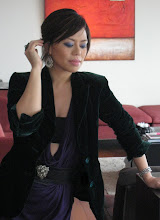
Up to 30% off on specially designed pieces.!
Be the first to view the 2008 Collection.
This Christmas, include JANINA in your wish list!
December 5-8, 2007
Opening hours 10 am - 6 pm
For more information,
please call +632 845 0140
There are some guidelines that can help but the bulk of it is you really can’t. As a trained gemmologist, you can make “visual” identifications but even then accuracy is not guaranteed. Tests and equipment are required that the average person without training does not have.
There are three tasks in gem identification:
a) What is it?
b) Is it natural or synthetic?
c) What type of enhancement (if any) has it had?
To illustrate: We see a red transparent stone, that is very sparkly and looks “clean” internally:
What is it? This is the easiest of all for a gemmologist to answer, as red glass, natural red spinel, natural red garnet, natural ruby, synthetic ruby, rubellite tourmaline and many other gems can look like this, but they will differ in optical, physical and chemical properties. So we test it and rule out all the major possibilities except ruby. But is it natural or synthetic -- a synthetic ruby has the same chemical reading of a natural one.
On to question two:
b) Natural or synthetic? Pricing will vary greatly between a natural or man made. There are many types of synthetic rubies and some are relatively easy to spot with a trained eye and the right gemmological equipment. For example, if we see internal structures under magnification called "curved striae" which is a curved banding of the stone-- end of story, it is a synthetic ruby. If we see a microscopic inclusion called "fingerprint" -- we have a natural stone. But, what if the stone is flawless or if the inclusions are ambiguous -- can be seen in either natural or synthetic (very commonly this is the case). At that point, a gem lab may be the only way to get an accurate ID.
Here are some examples of inclusions:
(where the real ruby is only at the top, a similar man made material is attached to the bottom)
curved striae in synthetic ruby
c) Is it enhanced? Let's say we determine that we have a ruby of natural origin. It still may have been enhanced by heat, diffusion, coating, filling or other methods to improve its clarity and colour. Again, some of these treatments are easy to spot if you have the equipment and knowledge, some are not. For example, an inclusion
called a stress fracture is indicative of heating and a fine and intact network of rutile fibers most commonly called “silk” indicates no heat, but there is a great middle ground here too, where it can be very difficult to determine the enhancement status of a gem. Heat treatments, by the way, are recognized and most commonly accepted within the jewellery industry as long as it is disclosed as such.

“silk ” inclusion in natural unheated ruby
fingerprint inclusion in ruby with heat treatment
As for diamonds, there are foolproof ways that you can test for authenticity.
Cubic zirconia -vs- diamond - jewelers have a simple tool that
tests the thermal conductivity of the stone with a metal probe and
reads either diamond or not diamond. (Pawn shop owners use these too). The recent
introduction of a new diamond simulant, Moissanite, has necessitated a
new generation of "diamond testers" as it will pass the thermal test
as a diamond --this one uses electrical conductivity which Moissanite does and a diamond doesn’t.
Note: Easy way to spot a fake diamond - Diamonds are the hardest known
substance. Any other facsimile of a diamond will be easily scratched
by sandpaper. Diamonds will not. If a store claims it is a diamond,
and you can scratch the surface with wet/dry sandpaper, then it is a
fake. But be warned for this is a destructive test.
Quite literally, there is a race going on between gem synthesizers and treaters who are seeking to make more and more realistic looking synthetics and simulants (either for honorable or dishonorable reasons), and the gemmologists who are trying to find ways
to detect each new treatment or synthetic.
These are the following tips I can provide in order not to get burned:
1) Deal with well established firms
2) Deal with individuals with credentials from well known institutions -- and who preferably have a money-back guarantee for the authenticity of their goods.
3) Lastly, if it is too good to be true, then it most probably is.
Whether you are buying, inherited or was given a gemstone as a gift, having your stones certified for its authenticity by a reputable gemmologist is highly suggested. It may cost a little more but then you will have greater peace of mind.
